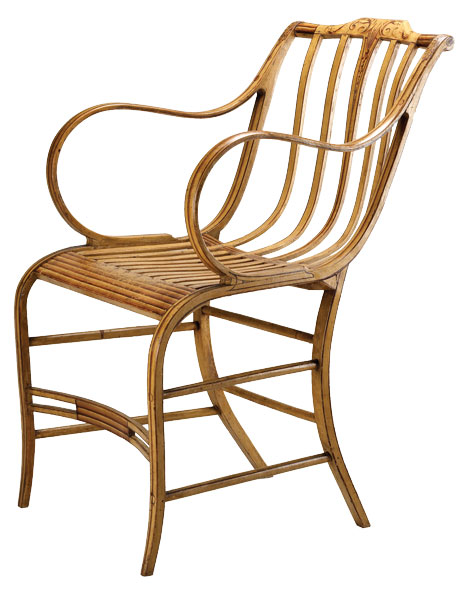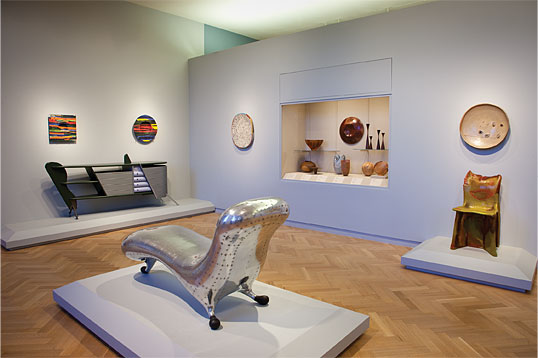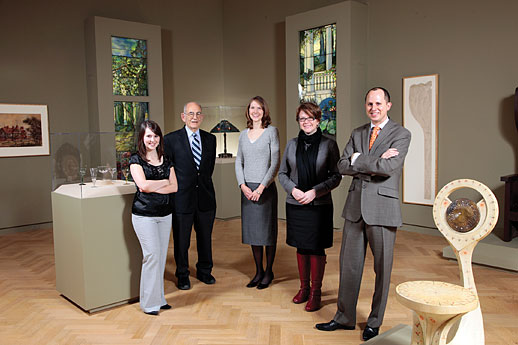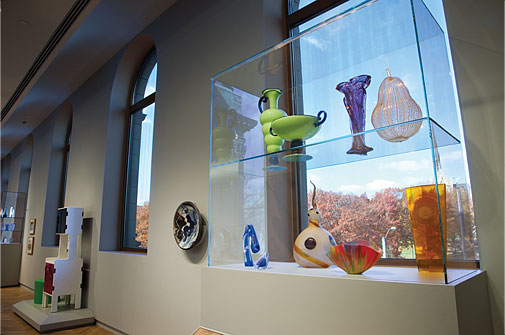Above: American, probably New York City or Philadelphia, Couch from the PicNic suite (detail), c. 1825. Bequest of Mary Schenley
Photos: Tom Little
”These objects have the power to tell a story and transport us.”
- Jason Busch |
 |
The Art of Daily Life
The reimagined Ailsa Mellon Bruce Galleries, home of decorative arts and design at Carnegie Museum of Art, celebrate the extraordinary in familiar objects.
By Cristina Rouvalis
It was the one that got away, thought Carnegie Museum of Art curator Jason T. Busch about the 1810 bentwood chair (below) by Boston furniture maker Samuel Gragg. In January 2006, Busch and his colleague Christopher Monkhouse at the Minneapolis Institute of Arts missed the opening of an antiques show in New York City where the chair was sold. He still winces at the lost opportunity to nab the rare gem, its wood pieces steam-bent vertically and horizontally to conform to the shape of the human back. “Ergonomically, it was so far ahead of its time,” he says, wistfully.

Samuel Gragg, Fully Elastic Armchair, c. 1810. Berdan Memorial Trust Fund
The Gragg chair and the Tennyson Vase (below), which took center stage at the 1867 World’s Fair in Paris, are featured just inside the entrance to the galleries.
Six months later, though, just as Busch was settling into his new post as Carnegie Museum of Art’s Alan G. and Jane A. Lehman Curator of Decorative Arts, the chair resurfaced—this time on the inside cover of Antiques magazine. “I was reading the magazine in bed one night and I couldn’t believe it,” Busch recalls. Not leaving anything to chance, he immediately picked up the phone and called the antiques dealer at 11:30 p.m. and was forced to leave a message. But he edged out other curators who waited until the next morning to pick up the phone.
The chair was a coup, and Busch’s first purchase in preparing for the recently re-interpreted Ailsa Mellon Bruce Galleries, which until their grand reopening November 21 had been off view for nearly a decade. The galleries now showcase, in all their glory, the 18th-century French furniture and German and English porcelain of Ailsa Mellon Bruce, the late daughter of Andrew W. Mellon; historic western Pennsylvania furniture; and glass and aluminum objects that mirror Pittsburgh’s industrial past. The galleries also bring museum-goers face-to-face with present-day treasures, including contemporary glass and wood.
Above all else, what the Bruce Galleries once again bring to life is the extraordinary in the ordinary. Take, for instance, the everyday chair. “The chair relates to the human person more than any other decorative art,” Busch says. “A chair has arms, legs, a seat, and a back, just as we do. It’s very tangible and very comforting.”
An impressive wall of more than two dozen chairs, mounted from floor to ceiling near the entry of the new Bruce Galleries, tells the history of innovative seating. On one end is an American turned wood chair, circa 1690, with restored green wool upholstery. On the other is ERO/S/, a 2001 blue plastic Philippe Starck chair shaped like a Martini glass. Some chairs are mounted high enough that visitors can view them from the bottom to get a glimpse of their construction. Phillip Johnston, former Carnegie Museum of Art director and curator of decorative arts from 1981 to 1988, says Busch focused on “objects of truly high merit” to encourage museum-goers to view household items as works of art.
“For so many people, art is painting,” Johnston says. “We have to face it: A chair is useful; a painting doesn’t have a use. We are broadening people’s point of view. If you look at a truly exceptional painting, it will sometimes take you out of the moment. The same thing can happen with a truly exceptional chair or piece of porcelain.”
In fact, the new Bruce Galleries feature fine arts interspersed with decorative arts, embracing the museum’s phil-osophy of integrating various art forms. Portraits of elegant ladies and distinguished gentlemen are mounted on the wall next to ornate furniture and sumptuous porcelain. “It tells you the kinds of people who lived during the period who would have owned these kinds of objects,” Busch says.
Reshaping the collection
When Busch accepted the curatorial position at Carnegie Museum of Art, it was a leap of faith. He had never seen the Bruce Galleries before their closing, and he wasn’t fully aware of the extent of the museum’s decorative arts and design collection.
Pittsburgh philanthropist and collector Ailsa Mellon Bruce, the galleries’ namesake, had a good eye and the means to furnish her many houses on the Eastern seaboard with distinguished works of art. After she died in 1969, her paintings were given to the National Gallery of Art; her decorative arts collection—nearly 3,000 items in all—was donated to Carnegie Museum of Art the following year. And as Jason Busch would quickly discover, three-quarters of the collection remained in storage.
In his first few months at the museum, “Every day was like Christmas,” he says. “We were throwing back the plastic wrappers and seeing great examples of 18th-century French furniture and colonial American furniture.” Busch was particularly impressed by the Baroque and Rococo German porcelain collection, part of which is now displayed on a wall of ceramics in the new installation.
Reshaping the collection—which, in part, was made possible by a $500,000 lead gift by the Women’s Committee of Carnegie Museum of Art—was a treat for the curator who had spent his childhood in Cleveland going to flea markets and antiques shows with his mother, Brenda. “After hopeless attempts to engage me in typical childhood activities in elementary school, she was desperate to find me an extracurricular activity. Little did she know that taking me to all those flea markets and garage sales would have an impact,” says Busch. His mother also enrolled him in Saturday morning art classes at the nearby Cleveland Museum of Art. “I wasn't much of an artist, but I learned how to appreciate art.”
Busch honed his specialty in 19th-century decorative arts during stints at the Wadsworth Atheneum Museum of Art in Hartford, Connecticut, and the Minneapolis Institute of Arts. After joining Carnegie Museum of Art, one of his first major decisions was to open the doors of the museum to dealers and collectors who could help evaluate the strengths and weaknesses of the collection. One example of a gap was 19th-century European silver—but that would change overnight.

Henry Hugh Armstead, designer, C.F. Hancock & Sons, manufacturer, Tennyson Vase, 1867. Ailsa Mellon Bruce Fund and Berdan Memorial Trust Fund
There is something to be said about being at the right place at the right time, explains Busch. And he was in just the right place at just the right time when he went to London in June 2007 to visit Martin Levy, an antiques dealer with a longstanding relationship with Carnegie Museum of Art. “I have something you might like to see,” Levy told Busch, as he brought out the four-foot-high, hand-hammered silver Tennyson Vase, an ode to Alfred Lord Tennyson’s poems about Arthurian legends and a symbol of the strength of the British Empire in the 19th century.
“To use the colloquial term, he flipped,” Levy says of Busch’s reaction. “He absolutely loved it.”
Busch marveled at the vase with figures and symbols from Arthurian legends bursting from its frame. “It was like reading a Tennyson poem,” he says. And, in fact, the vase itself has a storied history— so storied that Busch almost couldn’t get it out of England. “It was presented to Queen Victoria before being shown at the 1867 World’s Fair in Paris,” Busch explains. “So it was considered a national treasure, and I eventually learned that we had to get an export license before we could remove it from the country.” Fortunately, the export board gave its consent.
The Tennyson Vase and the Gragg chair are now showcased just inside the main entrance to the galleries. “They are two examples of eye candy to really draw people in,” says Busch.

The galleries also highlight contemporary design and craft in glass, wood, ceramic, and metal.
A regional connection
 Busch looked abroad for distinctive treasures, but he also scoured his backyard for regional items, including engraved glass tumblers by the famous Bakewell manufacturing firm in Pittsburgh, on loan from collector Harley Trice. Busch looked abroad for distinctive treasures, but he also scoured his backyard for regional items, including engraved glass tumblers by the famous Bakewell manufacturing firm in Pittsburgh, on loan from collector Harley Trice.
His relationship with collector David Brocklebank of Ligonier led to another of his favorite acquisitions—a clock with an exquisite wood cabinet that was made for the Goe family who lived in a Fayette County home called Friendship. The clock, which ended up in Brocklebank’s private collection, has a vine-and-leaf inlay pattern that meanders from the front to the sides. Visitors will see how inlay is made at one of the many interactive and hands-on displays scattered throughout the galleries.
“This is as good as it gets as far as a western Pennsylvania clock, circa 1800,” Busch says. “Collectors agree you would have a hard time finding a more refined example of the vine-and-leaf inlay decoration. The eye is drawn to the side as well as the front.” The cabinetry, which shares many of the traits of English clocks, was likely made by William Cock, a Fayette County craftsman who had apprenticed in Manchester, England.
Local collectors also helped Busch net treasures outside of western Pennsylvania. In Richard L. Simmons, Busch found a collector so knowledgeable about chairs that he became a research intern at Carnegie Museum of Art. Simmons, a physician and medical director of the University of Pittsburgh Medical Center, set up a fund to help acquire objects. Because of his interest in chairs, the money has gone toward the purchase of new ones, including Shiro Kuramata’s How High the Moon. Its shape is that of a traditional overstuffed club chair, but it’s made from nickel-plated mesh. “Was this truly meant to be used or seen as a sculpture? Probably more the latter,” explains Busch.
William Cock, cabinetmaker, Israel Gregg, clockworks maker, Osborne Manufactory, dial maker, Tall case clock, c. 1800. Berdan Memorial Trust Fund and Gift of Richard King Mellon Fundation, by exchange
Home suite home
The heart of the newly imagined Bruce Galleries is without a doubt a faux rosewood-grained and gilded parlor set from PicNic, a Greek Revival mansion in Stanton Heights built by William Croghan and last owned by his daughter, Mary Schenley.

Carnegie Museum of Art’s decorative arts and design team (left to right): curatorial assistant Dawn Reid, research intern Richard L. Simmons, assistant curator Rachel Delphia, departmental assistant Amanda Seadler, and Jason Busch, The Alan G. and Jane A. Lehman Curator of Decorative Arts.
“That is one of the best-documented groups of not only western Pennsylvanian but American high-style, fancy furniture,” says Sumpter Priddy, III, an antiques collector from Alexandria, Virginia, who helped evaluate the collection. “The Romantic movement and fancy taste were heading west. It’s just great to have that surviving furniture and to be able to tell a story about a local family.”
The house was demolished in the 1940s, but the parlor itself, sans the furniture, was moved to the University of Pittsburgh’s Cathedral of Learning. Carnegie Museum of Art was the fortunate beneficiary of 10 of the original 18 chairs and both couches, many of which the museum received in the 1930s from Mary Schenley’s estate.
At first, Busch wasn’t sure how to display such an important parlor set. After all, the museum doesn’t do brick-and-mortar re-creations of period rooms.

A stunning new feature of the Bruce Galleries: 20th-century glass displayed in front of large windows facing Forbes Avenue.
Museum staff measured the gallery space for the suite and discovered an amazing coincidence: its dimensions were incredibly close to the original parlor’s height and width. That’s when Busch got his inspiration: a life-size, line drawing of the parlor to cover the walls of the gallery space. “It’s almost like an architectural drawing,” he says. Local artist Jason Strom had such a good sense of perspective that the skillfully rendered columns and ornate moldings appear almost three dimensional, creating the perfect backdrop for Mary Schenley’s luxurious parlor suite.
It’s another example of Busch’s philosophy of decorative arts, which, in his view, is among the most accessible of art forms. “One can certainly lose oneself in a handsome mahogany chest or a beautifully rendered agate cup or a Gragg chair,” says Busch. “These objects have the power to tell a story and transport us.”
|






 Busch looked abroad for distinctive treasures, but he also scoured his backyard for regional items, including engraved glass tumblers by the famous Bakewell manufacturing firm in Pittsburgh, on loan from collector Harley Trice.
Busch looked abroad for distinctive treasures, but he also scoured his backyard for regional items, including engraved glass tumblers by the famous Bakewell manufacturing firm in Pittsburgh, on loan from collector Harley Trice. 
